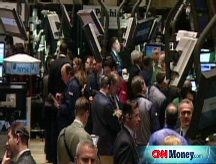A gallon of gas or a share of GM?
More than 5% of the firms in the S&P 500 are penny stocks, trading for less than $5 a share -- including GM, Motorola and Sprint. Be wary of reverse splits.

 |
| Sun Microsystems did a reverse stock split in November 2007 in order to boost ist stock price over $5. But a year later, shares of the struggling tech firm are back below $5 again. |
NEW YORK (CNNMoney.com) -- Most financial experts advise avoiding so-called penny stocks, typically shares of small companies with low stock prices that are not actively traded or followed closely by analysts.
First, a little clarification: The term "penny stock" refers to those companies with share prices of less than $5, not less than $1. (So maybe they should be called Lincoln stocks since Honest Abe's visage is featured on both the penny and $5 bill. But I digress.)
Usually, penny stocks are companies you've never heard of...ones that trade in the market netherworld of the Pink Sheets, not on the New York Stock Exchange or Nasdaq. But with the market in full ursine mode, many well-known companies can be dubbed penny stocks.
In fact, 27 of the S&P 500 had stock prices below $5 as of Monday's close. Struggling automaker General Motors (GM, Fortune 500) closed at just $3.18, while a share of rival Ford Motor (F, Fortune 500) hit $1.72 - less than a gallon of gas!
Not surprisingly, several financial stocks also are now Lincoln, err, penny stocks, including CIT Group (CIT, Fortune 500), E*Trade Financial (ETFC), Genworth Financial (GNW, Fortune 500) and the notorious AIG (AIG, Fortune 500). Heck, even two banks in the process of being acquired - Sovereign Bancorp (SOV, Fortune 500) and National City (NCC, Fortune 500) - are still in penny status.
A handful of brand-name techs, telecoms and retailers are also part of this unhappy club: Sprint Nextel (S, Fortune 500), Motorola (MOT, Fortune 500), Advanced Micro Devices (AMD, Fortune 500), Liz Claiborne (LIZ, Fortune 500) and Office Depot (ODP, Fortune 500) all cost less than a Subway foot-long sandwich.
And these companies could have friends if the market continues downward: 61 other S&P 500 firms have stock prices between $5 and $10 a share.
What's this mean for the average investor? It might be difficult to own these companies as part of a mutual fund portfolio since many funds prefer to steer clear of stocks trading below $5. Plus, once a stock crosses below that threshold it is often difficult for the share price to climb back because demand is low.
That's not good news. So it would not surprise me to see a new trend overtaking the markets: the reverse stock split.
Normally, a company splits its high-priced stock to make it more attractive to average retail investors. For example, a company with a $200 stock price may decide to do a 4-for-1 stock split. As a result, an investor who owned 100 shares at $200 each pre-split, would then have 400 shares worth $50 each.
The only thing that changed is the stock price. The value of this investor's stake remains the same: $20,000. Stock splits don't change a company's actual value, they just artificially deflate the stock price to make it seem cheaper.
In a reverse stock split, the opposite occurs. A company reduces the number of outstanding shares to jack up its stock price. So if a company that has a $5 stock price issued a 1-for-4 split, a post-split share would cost $20.
But again, this does not change the company's value. If you owned 1,000 shares trading at $5, and the stock splits 1-for-4, you'd wind up with 250 shares trading at $20. Your investment is still worth $5,000 even though the stock price has gone up.
Reverse stock splits are often warning signs of a company that's desperate to keep existing investors, entice new ones and, in some cases, avoid being delisted by exchanges with minimum-price requirements.
It is generally a bad idea to buy a stock that has done a reverse split, especially because many companies that do wind up becoming penny stocks again.
Sun Microsystems (JAVA, Fortune 500), for example, did a reverse stock split a year ago. At the time, the stock was trading at about $5. After a 1-for-4 split, the price went up to $20. But guess what? Sun now trades for just $3.61 a share.
Two other fairly well-known companies have also tried juicing their stock prices with reverse splits this year...and failed.
Semiconductor company Conexant Systems (CNXT), which was a member of the S&P 500 from January 2000 through June 2002, did a 1-for-10 split in June to lift its stock from 48 cents to $4.80. (How sad is it the stock was still a penny stock after the split?) On Monday, shares were trading for just $1.01.
And then there's cosmetics company Revlon (REV). It tried to pretty itself up for investors with a 1-for-10 split in September. That boosted the stock price from $1.25 to $12.50. But what's that saying about lipstick on a pig? Revlon's lost a third of its value since the split and closed Monday at $8.50.
So far, none of the prominent S&P 500 companies with stock prices below $5 have mentioned anything about using reverse stock splits. But I think it's only a matter of time.
And tomorrow, I'm going to take a closer look at a well-known company in the Nasdaq 100 that many have speculated is in sore need of a reverse stock split: Sirius XM (SIRI). A quarter is barely enough to buy one share of the satellite radio monopoly, which closed Monday at 23 cents a share. ![]()


